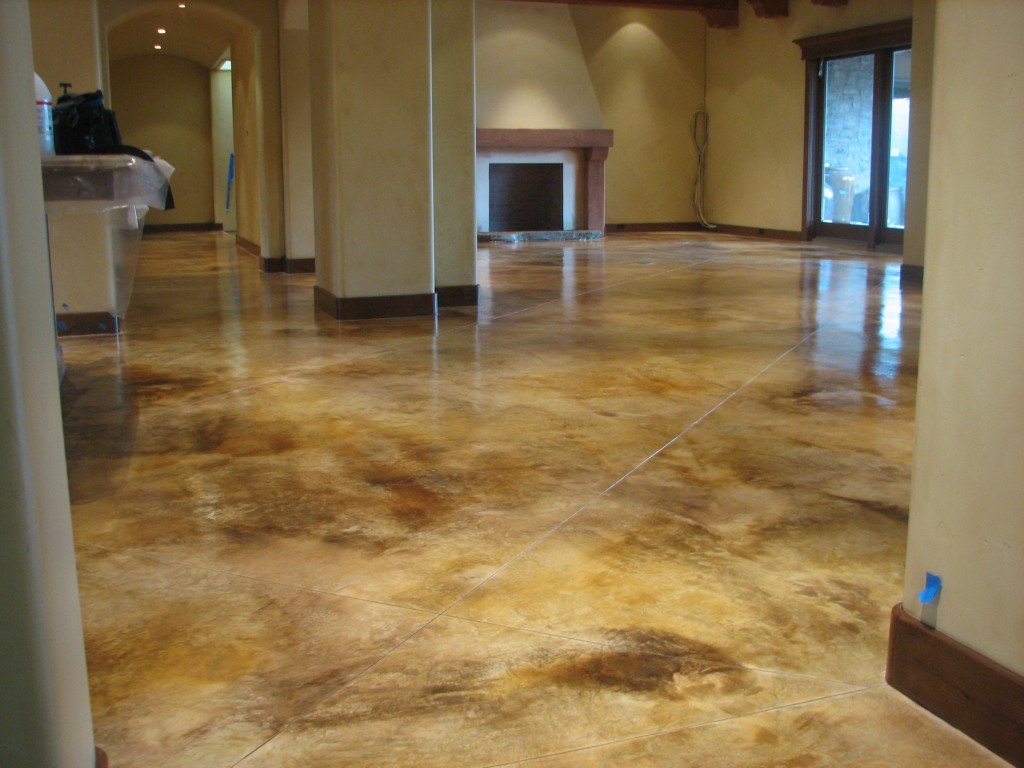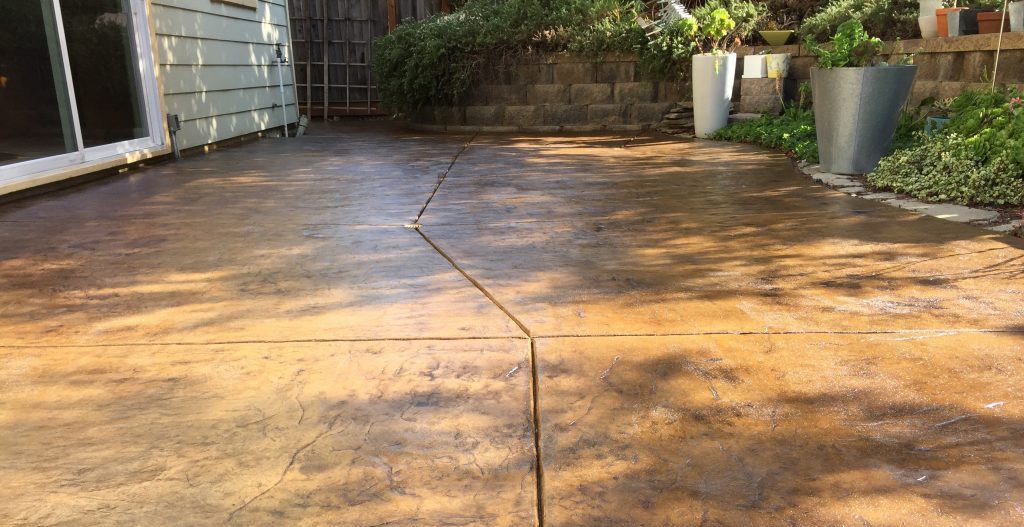Understanding the Various Sorts Of Stained Concrete for Your Next Project
Stained concrete offers different alternatives that accommodate different aesthetic and practical requirements. Each type presents distinct qualities that affect the last appearance and sturdiness of the surface. Recognizing these distinctions is essential for any person intending a project. From abundant, chain reactions of acid-based stains to the lively uniformity of strong shade stains, the selections can greatly affect the end result. What aspects should one take into consideration when picking the optimal stain for their details requirements?
Review of Stained Concrete
Stained concrete works as a flexible flooring alternative that can enhance the visual appeal of various areas. This method includes using a tinting representative to the surface area of existing concrete, enabling for a wide spectrum of style opportunities. Stained concrete is popular in both residential and business atmospheres, offering a resilient and low-maintenance service that can mimic the look of all-natural products like stone or floor tile.
The discoloration procedure can be performed making use of water-based or solvent-based items, each supplying distinct aesthetic impacts. The final appearance is influenced by elements such as the initial concrete surface, the type of stain used, and the application technique. Stained concrete not only improves interiors and exteriors yet likewise advertises sustainability by revitalizing existing concrete frameworks. Consequently, it has obtained grip among property owners and designers looking for both functionality and style in their flooring options.
Acid-Based Stains: Characteristics and Advantages

One-of-a-kind Color Variants
Concrete surface areas can transform dramatically with the application of acid-based stains, which offer an abundant combination of one-of-a-kind shade variations. These stains permeate the concrete, reacting chemically to generate vibrant earth tones that vary from deep browns and reds to soft greens and blues. The resulting shades are commonly variegated, developing a natural, marble-like look that improves the concrete's character. Each application yields distinctive outcomes because of variations in the concrete's composition and the staining technique made use of, making every task special. Furthermore, acid-based stains can be layered or integrated with various other strategies to create personalized styles, allowing for personal expression. This adaptability makes acid-based stains a prominent selection for both property and industrial applications.
Chemical Responses Clarified
While many variables add to the efficiency of acid-based stains, the underlying chemical reactions play an important duty in their special attributes and benefits. These stains largely consist of water, acid, and metallic salts. When related to concrete, the acid reacts with the calcium hydroxide in the cement, creating a chemical improvement that causes irreversible color changes. The metallic salts pass through the surface area and bond with the concrete, permitting a large variety of shades and tones. This reaction not just improves visual allure however additionally offers longevity, making the shade resistant to fading and wear. Additionally, acid-based stains can develop a variegated coating that simulates natural rock, additional enhancing their appeal for ornamental concrete applications.
Surface Prep Work Significance
Achieving suitable results with acid-based stains depends upon detailed surface prep work. This crucial step guarantees that the concrete surface area is clean, devoid of pollutants, and properly profiled for suitable stain absorption. Any kind of existing sealers, dirt, or oils can impede the chain reaction that generates the preferred shade and finish, bring about uneven or uneven results.
Prior to applying the discolor, the concrete needs to be mechanically cleaned or pressure washed, complied with by a detailed evaluation for fractures or blemishes that might call for repair. Additionally, confirming the surface is sufficiently dried will enhance stain adherence. By prioritizing these preparatory actions, the longevity and vibrancy of acid-based stains can be considerably boosted, resulting in a more visually pleasing and resilient surface.
Water-Based Stains: Attributes and Advantages

Water-based stains pass through the concrete, offering an extra translucent surface that highlights the all-natural texture and variations of the surface below. They are readily available in a wide array of shades, enabling imaginative adaptability in style. In addition, water-based stains are less complicated to tidy up, needing just water and soap, which streamlines the application process.
Their fast drying time improves performance, making them a practical option for both do it yourself fanatics and professionals. Generally, water-based stains give an appealing combination of aesthetic adaptability and straightforward properties, making them a popular alternative for concrete enhancement tasks.
Solid Color Stains: Dynamic Choices for a Strong Look
Solid color stains offer an effective service for those seeking to create a strong and dynamic aesthetic on concrete surface areas. These stains give a consistent pigmentation that can drastically improve the visual appeal of floors, outdoor patios, and driveways. Offered in a large range of hues, strong color stains permit imaginative expression, providing to numerous style preferences.
One of the key benefits of solid color stains is their capacity to hide blemishes, supplying a fresh and refined look to maturing concrete - stained concrete company. In addition, their formula normally includes UV-resistant residential properties, making certain durability and color retention also in harsh weather
Application is simple, requiring marginal preparation of the concrete surface area. When used, strong color stains can be sealed for added protection and luster, further boosting their aesthetic high quality. With their dynamic alternatives, solid color stains are a superb option for those intending for an impactful and cohesive design.
Semi-Transparent Stains: Accomplishing Depth and Measurement
Semi-transparent stains use an unique strategy to enhancing concrete surface areas by providing depth and dimension via numerous shade options. Comprehending the application techniques is vital for achieving the wanted effect, while appropriate maintenance methods important source assure longevity. This area will certainly explore these crucial facets to maximize the benefits of semi-transparent discoloration.
Shade Options Available
A wide range of shade options exists for semi-transparent stains, enabling home owners and developers to enhance the natural beauty of concrete surfaces. These stains are available in a variety of colors, from natural tones like browns and terracottas to vivid shades such as blues and greens. The semi-transparent nature of these stains allows the underlying concrete to reveal through, creating a distinct depth and dimension that can match different design looks. In addition, combining various colors can produce personalized tones, allowing a tailored search for each task. This adaptability makes semi-transparent stains a prominent option for both interior and exterior applications, as they can harmonize with surrounding components while including aesthetic rate of interest to plain concrete.
Application Strategies Explained
To attain the desired depth and measurement with semi-transparent stains, correct application strategies are crucial. Surface prep work is essential; the concrete needs to be clean and free of any kind of pollutants. This frequently entails power cleaning and repairing any cracks. Next, selecting the appropriate applicator, such as a sprayer, roller, or brush, can affect the final appearance. Sprayers enable a much more even application, while rollers can aid accomplish structure. It is very important to use the tarnish in thin, even layers, enabling each layer to dry prior to adding another. Controling the application method, such as varying stress or using various tools, can develop one-of-a-kind impacts. Ultimately, securing the stained surface area boosts the vibrancy of the colors while giving security.
Upkeep Best Practices
Routine upkeep is vital for maintaining the charm and honesty of surfaces treated with semi-transparent stains. To preserve these surface areas, routine cleaning is essential. Using a pH-neutral cleaner and a soft-bristle broom will certainly aid remove dust and debris without harming the tarnish. It is a good idea to stay clear of harsh chemicals, as they can break down the tarnish's appearance. Furthermore, periodic resealing each to 3 years can safeguard versus wear and fading. This procedure entails cleaning the surface thoroughly and applying a compatible sealant designed for stained concrete. House owners need to also keep track of for any type of indications of staining or damages and address these problems quickly to ensure durable vibrancy and durability. Following these best methods will certainly boost the total lifespan of semi-transparent stained surfaces.
Effects and Techniques: Customizing Your Stained Concrete
Tailoring stained concrete entails a selection of methods that improve both appearances and functionality. Among these methods, layering various discolor colors can create deepness and intricacy, enabling special aesthetic impacts. Techniques such as acid discoloration offer a variegated look, while water-based stains next provide an extra consistent appearance.
Additionally, integrating attractive patterns, such as stenciling or engraving, can even more personalize the surface, including intricate layouts that cater to specific tastes. Texturing the concrete, whether through marking or broom surfaces, introduces responsive aspects that not just enhance grip yet likewise enhance aesthetic rate of interest.
In addition, using sealants can enhance the shade vibrancy and supply protection versus wear. Customization strategies extend past mere shade; they can transform a typical concrete slab right into a spectacular prime focus, making it appropriate for both residential and industrial spaces. Via careful option of effects and strategies, stained concrete can achieve an absolutely tailored look.
Maintenance and Durability of Stained Surfaces
Although stained concrete surfaces are recognized for their longevity and visual appeal, keeping their stability is essential for making certain durability. Normal cleaning is important; sweeping and wiping with a pH-neutral cleaner aids protect against dirt buildup and staining. Furthermore, applying a sealant every couple of years can shield the view it now surface from moisture, chemicals, and UV damage, thus improving its life expectancy.
It is likewise vital to attend to any type of cracks or chips without delay. Little repairs can reduce additional damage, preserving the visual and structural high quality of the surface. For outside stained concrete, seasonal upkeep, such as removing snow and ice, is required to avoid surface damage from freeze-thaw cycles.
Often Asked Concerns
Can I Stain Existing Concrete Surfaces or Brand-new Ones?
The concern of whether existing concrete surfaces can be stained develops often. It is indeed feasible to discolor both brand-new and old concrete, supplied the surface is properly ready and complimentary of pollutants for ideal attachment.
How much time Does the Staining Refine Normally Take?
The staining procedure generally takes one to 3 days, depending on variables such as surface area preparation, kind of stain, and climate condition. stained concrete company. Curing time might extend beyond initial application, affecting the overall duration substantially
Is Stained Concrete Safe for Outdoor Use?
Stained concrete is normally safe for outside use, gave it is effectively sealed. This securing protects against wetness and UV damages, guaranteeing sturdiness and safety and security, while additionally enhancing the aesthetic appeal of outdoor areas.
Can I Apply Several Stain Layers for Various Results?
Using multiple stain layers can accomplish diverse results on stained concrete. It is important to assure compatibility in between stains and permit proper drying out time between applications to avoid unintentional reactions or discoloration.
Are There Any Shade Limitations for Stained Concrete?
Color constraints for stained concrete largely depend upon the sort of tarnish used, with water-based stains offering a more comprehensive scheme contrasted to acid-based stains. stained concrete company. Nevertheless, accomplishing lively colors may call for mindful option and application strategies